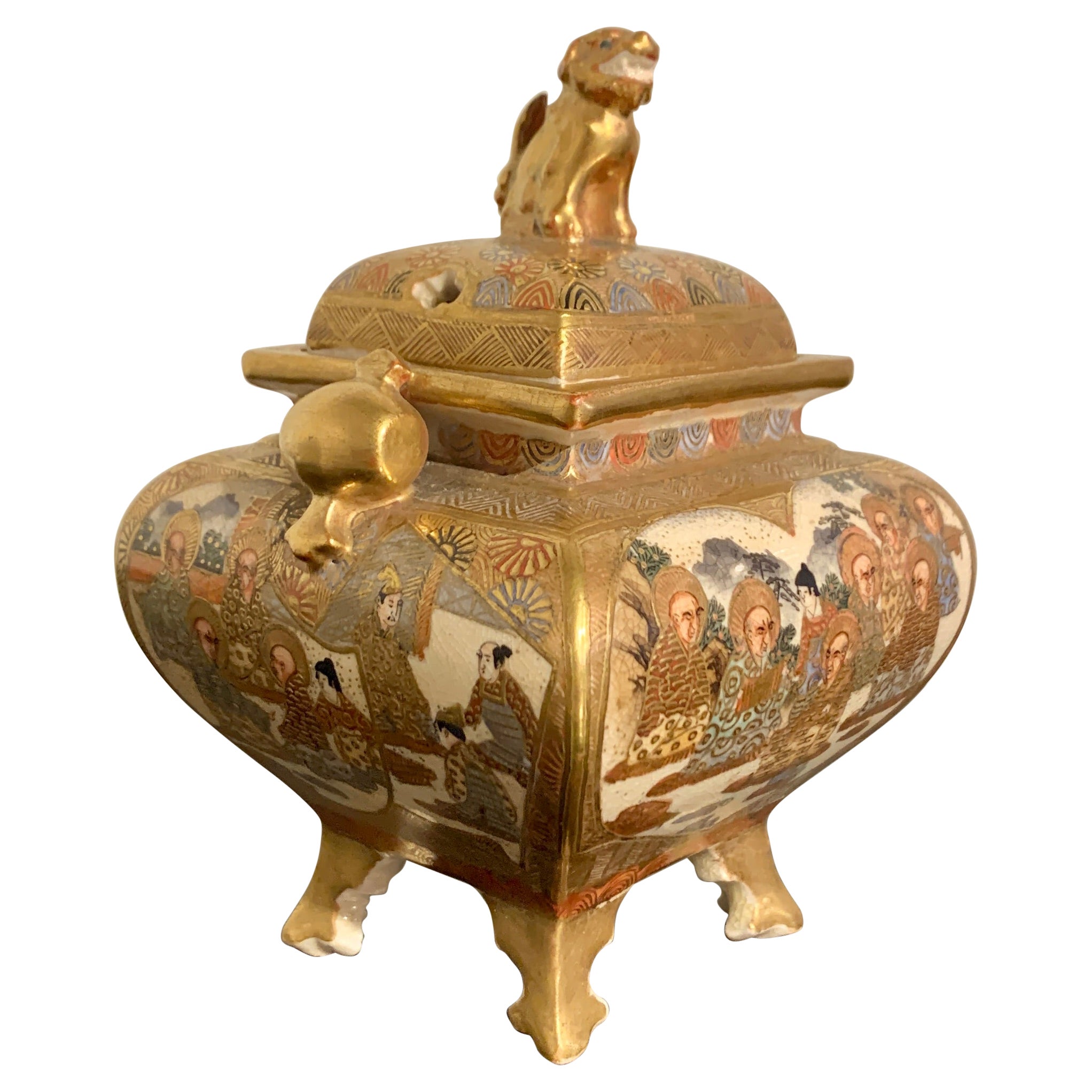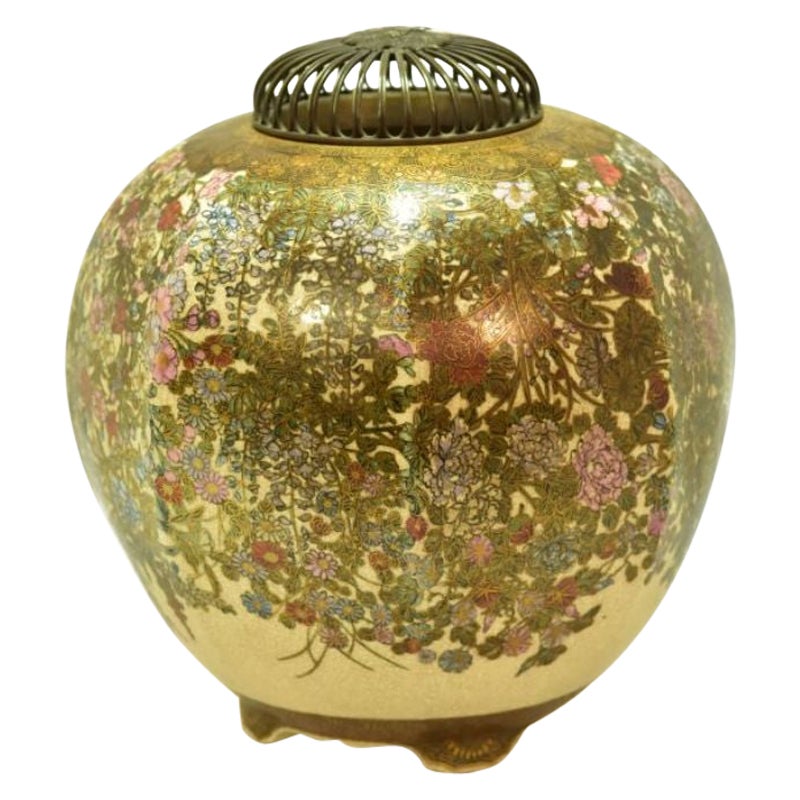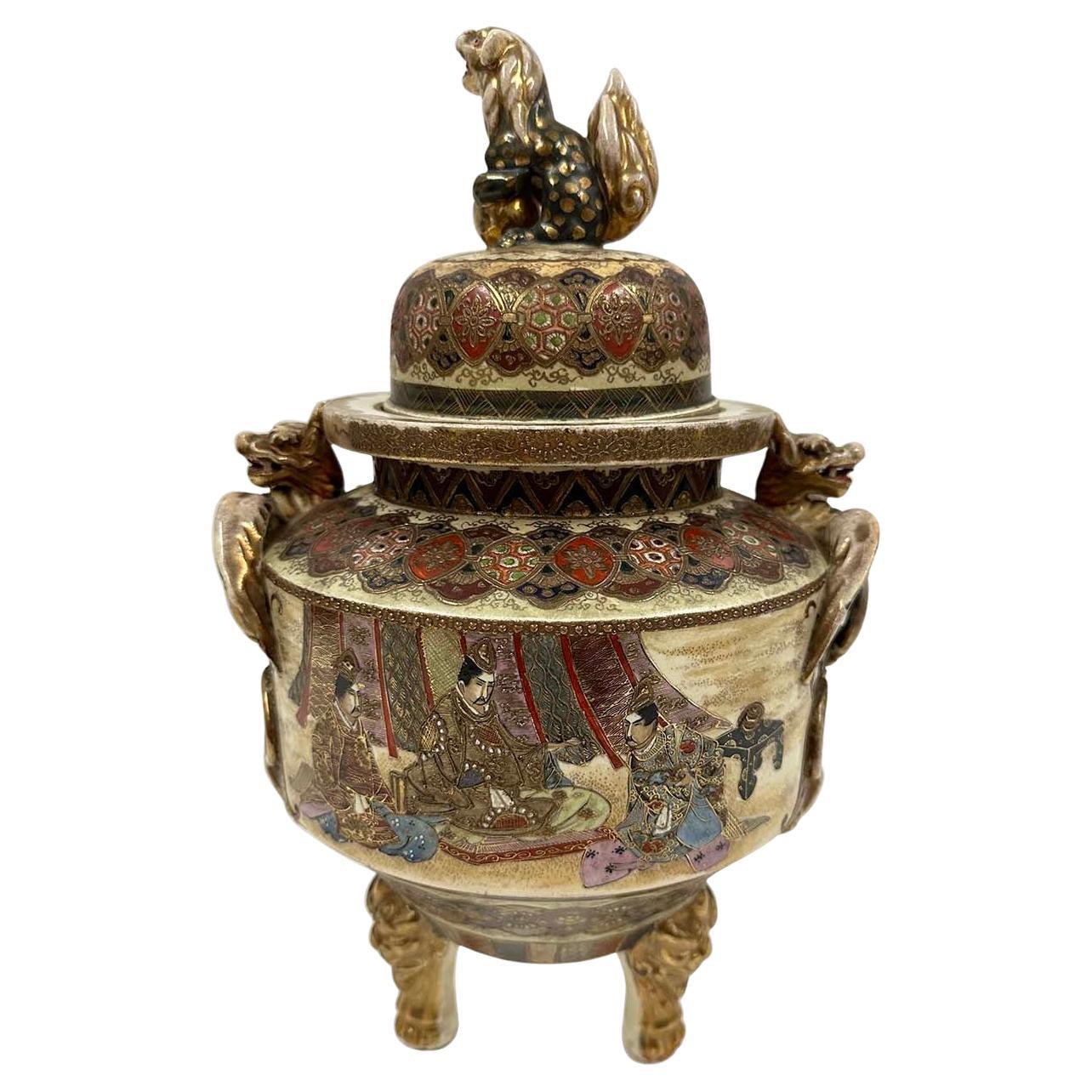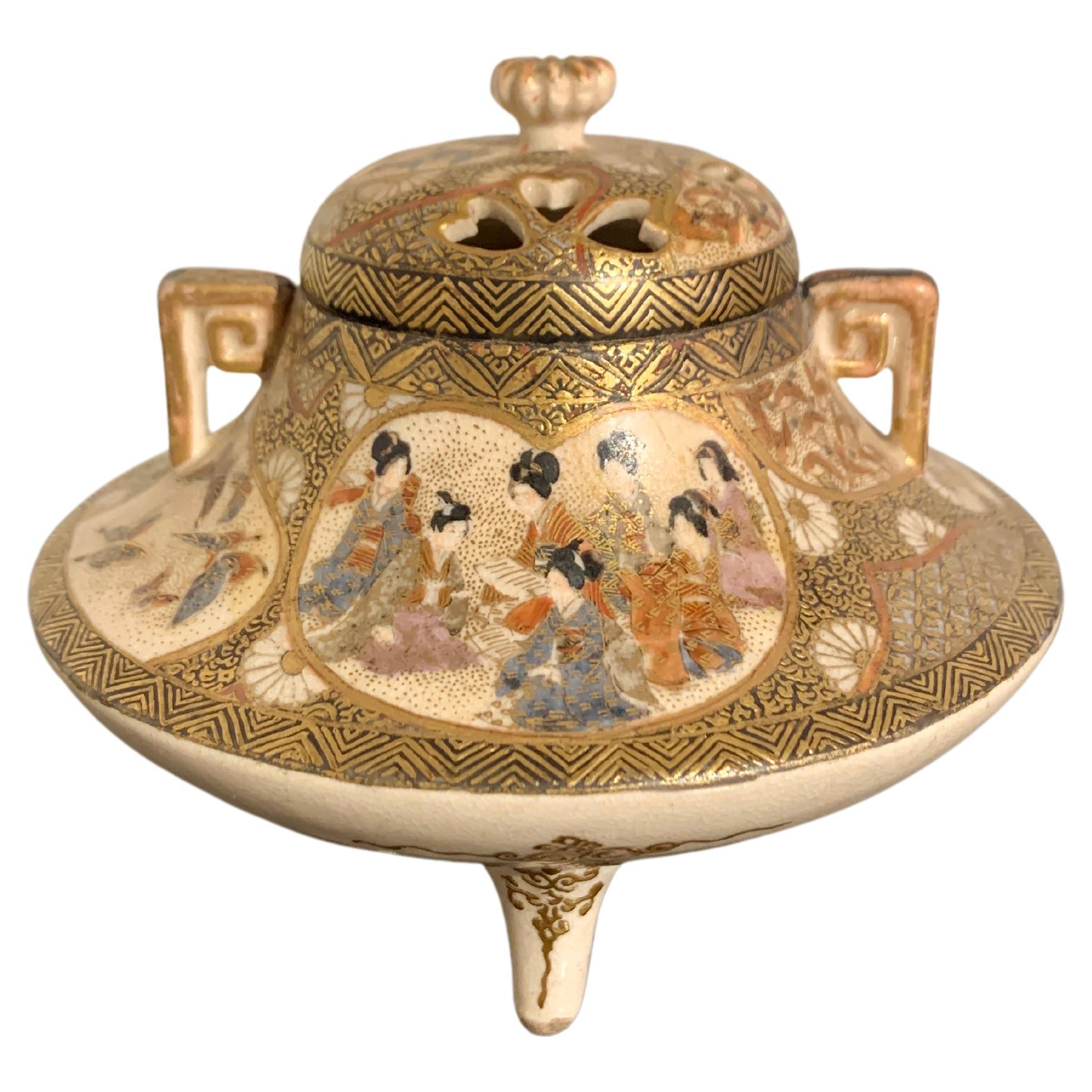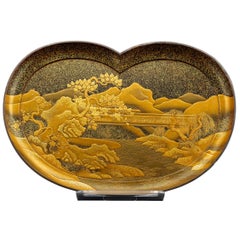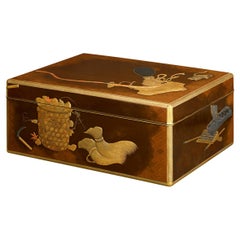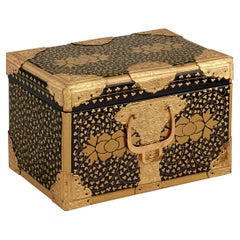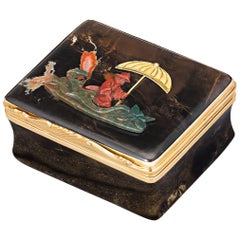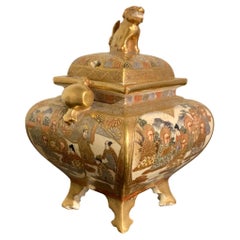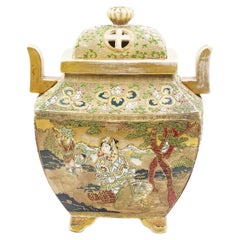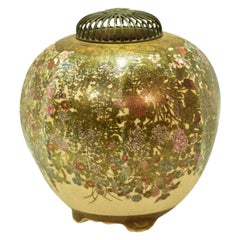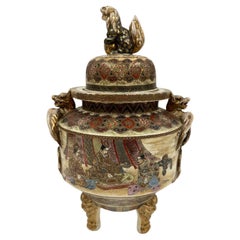Items Similar to Satsuma Incense Burner
Want more images or videos?
Request additional images or videos from the seller
1 of 5
Satsuma Incense Burner
$3,450
£2,653.97
€3,080.50
CA$4,865.32
A$5,449.98
CHF 2,862.53
MX$66,270.02
NOK 36,248.94
SEK 34,409.99
DKK 22,991
About the Item
This Japanese Satsuma incense burner is a decorative work of art from the Meiji period, distinguished by its exquisite craftsmanship and intricate detailing. Made from fine earthenware, this burner features a creamy, off-white glaze adorned with vibrant overglaze enamels and gold detailing. Lively scenes are on full display on each side, featuring tea ceremonies, the playing of instruments and children playing. Used for burning incense during ceremonies, Satsuma incense burners exemplify the blend of form, function and artistic beauty characteristic of Meiji-era Satsuma ware.
This burner has a round shape with a perforated, dome-shaped lid and is supported by intricately decorated feet. A stunning and utilitarian object such as this would have been highly prized both domestically and internationally. It is marked with the Shimazu family crest, or mon, and the artist's signature, indicating their origin from the Satsuma region.
The signature contains the characters of the signature for Hozan for the artist Matsumoto Hozan at the Kyoto-based workshop in the Meiji period. Hozan also worked for Yasuda and produced some of the highest quality satsuma ware on the market.
For nearly 150 years, Satsuma earthenware has captivated collectors and is regarded as a quintessential art form of the Meiji period. Initially crafted in the 17th century, this luminous style reached its height around 1790. Originating near Kagoshima Prefecture on Kyushu Island, Satsuma ware was initially produced by Korean potters for the Shimazu family and the local populace. Its international acclaim soared after its exhibition at the 1867 Exposition Universelle in Paris. Subsequently, Satsuma ware was widely commissioned for export to the West, with production expanding to major Japanese cities such as Kyoto, Osaka, Tokyo and Yokohama.
Signed with the characters of “Hozan" in Japanese and the Shimazu family crest
Meiji period (1868-1912)
5" high x 4" in diameter
- Dimensions:Height: 5 in (12.7 cm)Width: 4 in (10.16 cm)Depth: 4 in (10.16 cm)
- Style:Meiji (Of the Period)
- Materials and Techniques:
- Place of Origin:
- Period:
- Date of Manufacture:19th Century
- Condition:
- Seller Location:New Orleans, LA
- Reference Number:Seller: 31-90931stDibs: LU891145819632
About the Seller
5.0
Recognized Seller
These prestigious sellers are industry leaders and represent the highest echelon for item quality and design.
Established in 1912
1stDibs seller since 2010
109 sales on 1stDibs
Typical response time: 4 hours
- ShippingRetrieving quote...Shipping from: New Orleans, LA
- Return Policy
Authenticity Guarantee
In the unlikely event there’s an issue with an item’s authenticity, contact us within 1 year for a full refund. DetailsMoney-Back Guarantee
If your item is not as described, is damaged in transit, or does not arrive, contact us within 7 days for a full refund. Details24-Hour Cancellation
You have a 24-hour grace period in which to reconsider your purchase, with no questions asked.Vetted Professional Sellers
Our world-class sellers must adhere to strict standards for service and quality, maintaining the integrity of our listings.Price-Match Guarantee
If you find that a seller listed the same item for a lower price elsewhere, we’ll match it.Trusted Global Delivery
Our best-in-class carrier network provides specialized shipping options worldwide, including custom delivery.More From This Seller
View AllJapanese Lacquer Tray
Located in New Orleans, LA
As beautiful as it is practical, this Japanese Meiji-period lacquered tray is distinguished by its exceptional craftsmanship. It exhibits a phenomenal artistry as the entire tray is ...
Category
Early 20th Century Japanese Meiji Lacquer
Materials
Lacquer
$8,850
Japanese Lacquer Box
Located in New Orleans, LA
This exquisite Meiji-period lacquer document box known as a ryoshibako showcases the meticulous artistry of maki-e, a technique of raised lacquer decoration. Adorned with gold and vi...
Category
Antique 19th Century Asian Meiji Lacquer
Materials
Gold
$39,850
Edo-Period Lacquerware Chest
Located in New Orleans, LA
Edo-Period Lacquerware Chest
19th-century
This exquisite chest, inspired by Hasami-Bako travel trunks, is a striking example of Japanese lacquerware. The hiramaki-e technique—applie...
Category
Antique 19th Century Japanese Edo Decorative Boxes
Materials
Gold
French Chinoiserie Hardstone Snuff Box
Located in New Orleans, LA
A marvelously carved chinoiserie motif adorns the lid of this incredible 19th-century French tabatière or snuff box. The charming scene is intricately crafted in the form of a boating figure who holds aloft an umbrella formed of yellow gold, while the box itself is crafted from attractive brown hardstone mounted with stunning yellow gold "waves." Enchanting and beautifully executed, the rare snuff box is an incredible example of the creative artistry of these delightful boxes, as well as the highly popular chinoiserie style.
Inhaling snuff, or snuffing, as it is also called, was a popular social ritual among the European elite from the 16th through the 19th centuries. Over these 300 years, master artisans created and designed elegant snuff boxes using...
Category
Antique 19th Century French Chinoiserie Snuff Boxes and Tobacco Boxes
Materials
Stone, Gold
Gold Lacquer Incense Box
Located in New Orleans, LA
A Gold Lacquer Kōbako (Incense Box)
Edo Period (1615–1868), Circa 1850
This exquisite gold lacquer kōbako (incense box) exemplifies the refined craftsmans...
Category
Antique 19th Century Japanese Edo Decorative Boxes
Materials
Gold, Silver, Gold Leaf
$9,850
Chinese Cinnabar Lacquer Cuspidor
Located in New Orleans, LA
This intriguing Chinese zhadou is intricately carved of fine cinnabar lacquer. A work of exceptional artistry, this covered bowl is adorned with an intricately carved floral motif on all surfaces, including the cover and the wide rim. Also known as a cuspidor or spittoon, this rare container would have been used by members of the imperial family and scholar- officials at the court. Carved during the Kangxi period (1662-1722), this charming piece exhibits the high detail and charm associated with items from that period, making it a true treasure,
Early 18th century (Kangxi dynasty)
Measures: 6 ¼” wide x 3 ¼” high
Cinnabar has been revered for its color all over the world. It has been found in the royal burial chambers of the Mayas, in the rituals of India, and in the ruins of ancient Greece and Rome. In China, cinnabar and gold were the two most important elements in alchemy. Mined since the Neolithic Age, cinnabar is the ore of mercury, and as such, it can be incredibly toxic, especially when mining. In fact, during the Roman Empire, miners at Spain’s Almadén mine in Spain were frequently exposed to mercury fumes, and the subsequent, often fatal, sickness was considered an occupational hazard.
The most popular known use of cinnabar is in Chinese carved lacquer-ware, a technique that is believed to have originated in the Song Dynasty, in which cinnabar is ground to a powder and added to clear lacquer. As with mining, there was inherent danger of mercury poisoning for those who carved the lacquer, as mercury was also released into the air when artisans ground the pigments. Most antique cinnabar...
Category
Antique 18th Century Chinese Other Lacquer
Materials
Lacquer
You May Also Like
Small Japanese Satsuma Incense Burner, Koro, Meiji Period, Late 19th Century
Located in Austin, TX
A fine Japanese Satsuma stoneware incense burner, koro, Meiji Period, late 19th century, Japan.
The koro of square shape with curved sides,...
Category
Antique 1890s Ceramics
Materials
Enamel
Koro Satsuma Japanese ceramic
Located in Buenos Aires, Argentina
Koro Satsuma Japanese ceramic
Japanese glazed ceramic in various colors
Meiji Style Circa 1940 Origin Japan
It has traditional images painted on its front and back.
The purpose of th...
Category
Vintage 1940s Japanese Meiji Ceramics
Materials
Enamel
Incense Burner in Satsuma Earthenware
Located in Marseille, FR
JAPAN - Circa 1900 Incense burner in Satsuma earthenware with vegetal decoration. Openwork lid in shibuichi surmounted by a flower in slight relief...
Category
Antique 19th Century Japanese More Asian Art, Objects and Furniture
Materials
Earthenware
Antique Japanese Meiji Period Satsuma Incense Burner Censer
Located in Pomona, CA
UP for you consideration is a beautiful antique Meiji period Japanese gold gilt satsuma incense burner marked/signed by Kinkozan. Very fine hand...
Category
Early 20th Century Japanese Chinese Export Urns
Materials
Porcelain
$971 Sale Price
25% Off
Miniature Antique Japanese Satsuma Pottery Censer or Koro
By Kinkozan
Located in Philadelphia, PA
A fine antique Japanese Satsuma pottery incense burner.
With a cream ground and an extensively gilt exterior.
There are numerous cartouches around the censer with each having a un...
Category
Early 20th Century Meiji Ceramics
Materials
Pottery
Japanese Satsuma Tripod Censer, Koro, Meiji period, Early 20th Century, Japan
Located in Austin, TX
A small and finely decorated Japanese Satsuma tripod incense burner (koro), signed Kyozan, Meiji period, circa 1900, Japan.
The censer, koro, with a compressed body supported by t...
Category
Antique Early 1900s Japanese Meiji Ceramics
Materials
Stoneware
More Ways To Browse
Fukagawa Koransha
Guanyin Ceramic
Ming Vase Dress
Glazed Censor
Guan Ware
H C Dexter
Gunnar Nylund Seal
Higa Pottery
Japanese Porcelain Dish Y Y
Patrick Bergsma
Japanese Shoki Imari
Modern Japanese Studio Pottery Oribe Vase
Satsuma Bucket
Porcelain Qing Kangxi Dragon Bowl
Takahashi Rakusai
Chinese Familia Vases
Fabricado Em Macau
Java Piggy Bank
